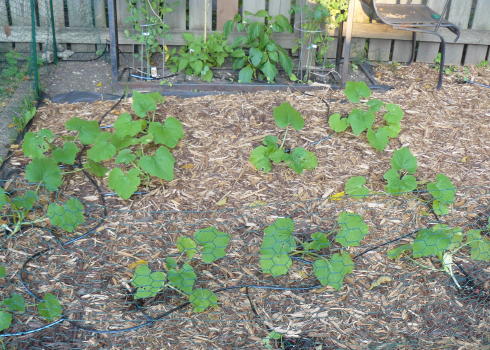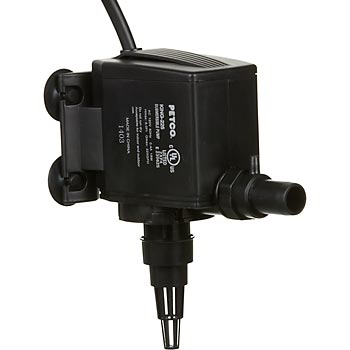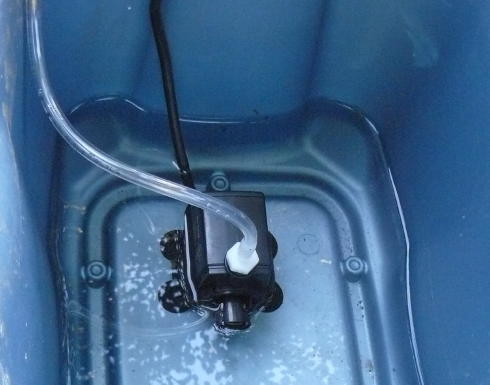With my sincerest apologies to the beloved political junkies who visit this site (and seriously, because I’m one myself, you know you are always very welcome here), it’s time for a bland post about gardening.
It’s been three weeks and five days since I started my backyard vegetable garden, and as I have had to learn from scratch and started way late in the growing season, this is more of an experiment than anything else. (I didn’t plant any tobacco, though, as it is too late in the season for such a frost-sensitive plant.) Having nothing more than the Internet as my guide, I determined that there are several things which can be started late in the summer, so in addition to the tomatoes and a pepper that I bought as plants I am growing zucchinis, broccoli, Swiss chard, and peas.
Here’s a partial view.

As you can see, I learned that a drip irrigation system beats using a watering can.
However, plants need fertilizer. I like using my aquarium water to water plants, and I might also like to fertilize them with Miracle Gro or something, but that presented problems because the drip system is fed from the hose bib by an attachment. After putting in all of the work to install the nearly 40 drippers, it struck me that they would be a highly efficient way to introduce whatever liquid fertilizer I wanted by injecting it directly.
It’s not a new idea; it’s called fertigation.
Not a bad article, except that under “Disadvantages” it lists this:
“Use of chemical fertilizers of low-sustainability, instead of organic fertilizers.”
I take offense at that, and I will have Wikipedia know that my used aquarium water is about as organic as you can get!
Anyway, to make my drip system fertigation-capable seemed to require purchasing additional units — meaning time and money. (The cheapest injection units I found cost over $60.00.) I have a couple of standard Petco aquarium powerheads lying around, which look like this:

They’re surprisingly powerful, and it occurred to me that as a pump is a pump, I might be able to use it for other than it’s intended purpose of creating a powerful underwater current in an aquarium. I’m always siphoning water from the tanks into plastic bins, and I’ve also been putting it into the watering can and laboriously watering each plant with it. So, I thought, why not just put the bin full of aquarium water near the vegetable bed, add a tee to one of the lines, and then pump the aquarium water directly into the line feeding the drippers?
At the hardware store, I found an adapter for 99 cents which could be screwed directly into the pump’s threaded discharge outlet. All I had to do was unscrew the existing discharge fitting, screw it in, attach a compatible hose, hook that into the tee, throw the pump into the bin and plug it into an extension cord. The result?

A fertigation system, for very little money!
The drippers all started dripping aquarium water at a rate indistinguishable from that of the hose bib, and in about ten minutes or so, the tub was nearly empty. Much easier than the watering can. (And more efficient, as you don’t spill water on the plants or lose any to evaporation.) I still have to get the water from the fish tanks into the bin, but I have a siphon long enough to reach out the window and directly into the bin. While it might seem like a nuisance, it really isn’t an additional nuisance, because I have to change the aquarium water anyway.
Being free, aquarium water is a lot cheaper than Miracle Gro, and it said to be very high in the nutrients plants need. The problem is, there’s no way to know with any degree of accuracy what the NPK (Nitrogen, Phosphorus, and Potassium) ratios are, and it varies from water change to water change:
The N-P-K would naturally be relevant to the fish load and how long the tank has been setup.. By the time you tested it would be different again lol. My guess is that it’a about a third of the necessary nutrients for most plants. The great part is that it could never burn and all the elements are in a stable form. Certainly better than straight tap water,but wouldn’t expect to quit fertilizing.
I think I could use store-bought fertilizer every couple of weeks instead of weekly, although some online gardeners state that aquarium water is all you need.
Sheesh, what a boring post. Readers come here expecting to see exciting discussions of controversial issues, and hopeless arguments dissected down to the last hopeless bone. And here I am talking about how to be a cheapskate backyard gardener.
Well, to spice things up a bit, I might as well mention a form of natural fertilizer I have not tried yet: urine.
Oh yes:
maybe you didn’t know that human urine is the fastest acting, most excellent source of Nitrogen, Phosphorous, Potassium and some trace elements. Not only that, but we all have a constant, year round supply of it – and it’s free! There’s not a lot of effort involved in creating this wonderful organic liquid fertilizer.
Some men I know are more than happy to oblige a tree, bush or lawn (out of view, of course).
Did you know that many toilets use between 50 and 100 litres of water a day to flush around 1.5 litres of pee? And the high levels of nutrients in our effluent systems leads to the growth of algae, which ultimately causes the death of plants and animals throughout our waterways.
What are the advantages of using urine as an organic liquid fertilizer?
# If you’re not flushing this valuable liquid down the loo, you are reducing your water consumption – good for the environment and your pocket
# You’ll be reducing the amount of sewerage runoff
# There’ll be less nutrients in our waterways
# Urine as a liquid fertilizer is available in an ideal chemical form for plants to use
# Gardening costs are less as your liquid fertilizer is free
# It is readily available all year round and there are no transportation costs
Just so that you know, fresh human urine is sterile (unless there is a urinary tract infection – this urine should not be used) and so free from bacteria.
I recommend that you dilute urine to 10-15 parts water to 1 part urine for application on plants in the growth stage. Dilute to 30-50 parts water to 1 part urine for use on pot plants as they are much more sensitive to fertilizers of any kind.
Well now, isn’t that nice to know? I had no idea that I have been flushing away perfectly good organic and natural fertilizer. (But OTOH, aren’t we humans supposed to be unnatural?)
As to whether I should be peeing into my water bin, I don’t know. Perhaps readers can assist me. (Assist me in the decision process, of course.) I’m thinking that this might be the sort of thing that a gardener who did it might want to keep to himself, especially if you want people to be enthusiastic over your vegetables at the dinner table. (Obviously, I have no desire to get caught up in any sort of “fertigate scandal.”) And is it legal for farmers to add piss to their crops?
Anyway, I hope I managed to inject a wee bit of controversy into the otherwise dull issue of fertigation.
I only hope no one was pissed by my, um, flow.
AFTERTHOUGHT: A question of guilt to ponder. What should I feel more guilty about?
— wasting perfectly good liquid fertilizer with every flush?
or
— the fact that I injected “guilty urine” into an otherwise innocent discussion?
Comments
6 responses to “Fertigate, and how! (A dull and non-controversial issue…)”
Horse Manure works very well and your local stables are usually glad to have you take it away.
Incidentally, you can also remove the water from the urine and use the resultant crystals as a saltpeter substitute to make black powder.
Doesn’t have to be human, either; the contents of your catbox can be rendered also.
“human urine is the fastest acting…”
Which also mean you could quickly overdo it and burn your plants.
I would start off with really small amounts and work up slowly.
Wait, you’ve been using store-bought fertilizer weekly?
For annual crops (corn, beans, squash, tomatoes, and such), I generally work a little all-purpose fertilizer into the soil, along with some compost, before spring planting, and after that the plants seem to get by just fine on water and sunshine.
For more permanent vegetation (e.g., blueberry bushes), a sprinkling of granular fertilizer around the base of the plant at the beginning of rainy season ought to get the job done.
Of course, as long as you have the aquarium water, it makes sense to apply it to the plants… but do you really need the regular doses of commercial fertilizer?
How would the drugs some of us take affect plants fertilized by urine? Would an antidepressant make them happier? Would a benzodiazepine make ’em chill? Would metformin help them metabolize sugars better?
Would statins make vegetables even MORE healthy?
Eric I have been giving them aquarium water once a week, but I recently read that it doesn’t supply enough nutrients. I started with just the plain soil, whatever is in there; I turned it over, covered it with weedblock and mulch, then stuck in the sprouts.
Interesting question about medication, Donna.